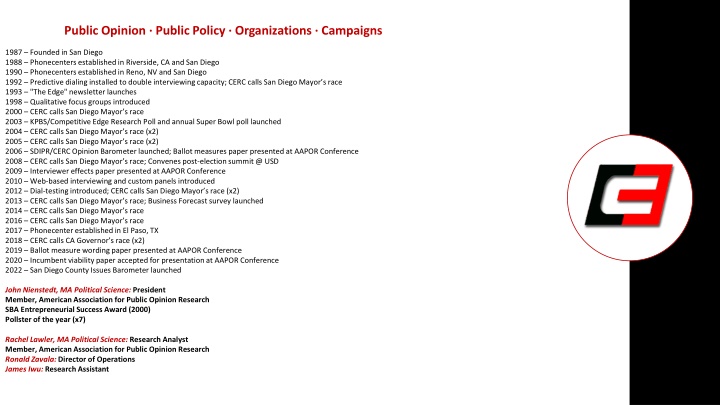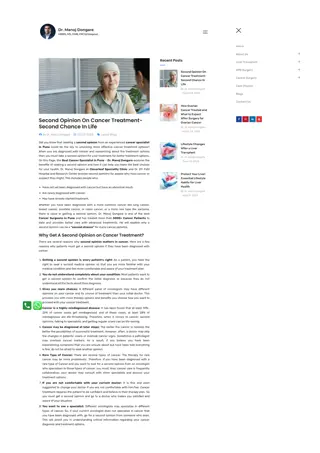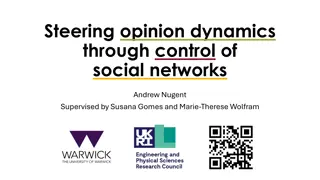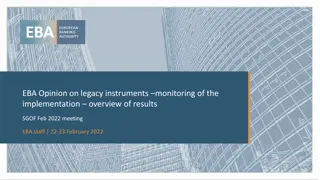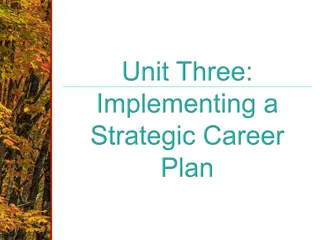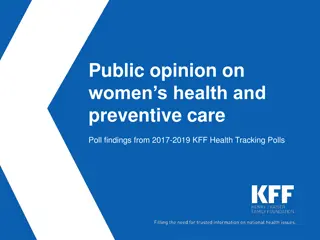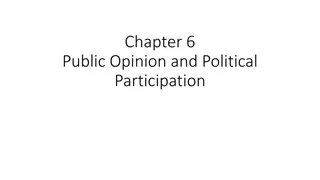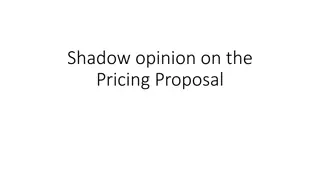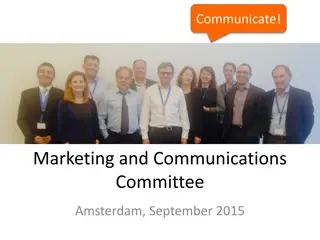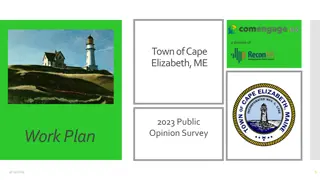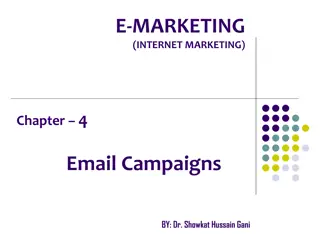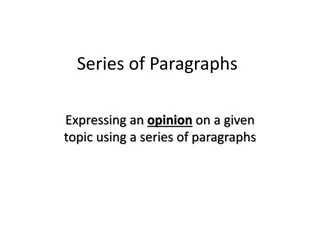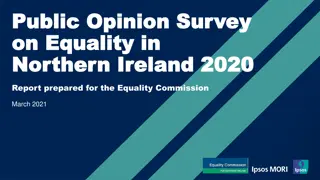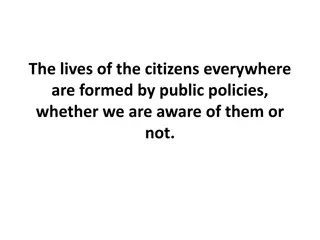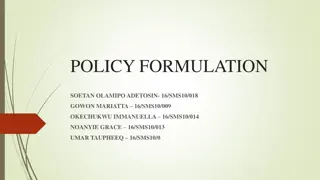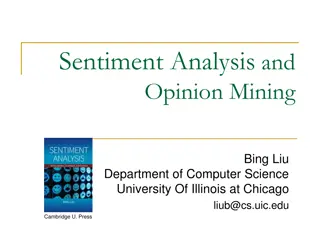Public Opinion · Public Policy · Organizations · Campaigns
Founded in 1987 in San Diego, this organization conducts public opinion research and campaigns focusing on important civic issues. Over the years, it has evolved with the introduction of new methodologies and initiatives, such as predictive dialing and web-based interviewing. The team includes experienced professionals recognized for their expertise in political science and research analysis, ensuring high-quality data collection. The latest project in San Diego County aims to document changes in civic mood and delve into cost of living concerns among adult residents through various interviewing methods.
Download Presentation

Please find below an Image/Link to download the presentation.
The content on the website is provided AS IS for your information and personal use only. It may not be sold, licensed, or shared on other websites without obtaining consent from the author.If you encounter any issues during the download, it is possible that the publisher has removed the file from their server.
You are allowed to download the files provided on this website for personal or commercial use, subject to the condition that they are used lawfully. All files are the property of their respective owners.
The content on the website is provided AS IS for your information and personal use only. It may not be sold, licensed, or shared on other websites without obtaining consent from the author.
E N D
Presentation Transcript
Public Opinion Public Policy Organizations Campaigns 1987 Founded in San Diego 1988 Phonecenters established in Riverside, CA and San Diego 1990 Phonecenters established in Reno, NV and San Diego 1992 Predictive dialing installed to double interviewing capacity; CERC calls San Diego Mayor s race 1993 "The Edge" newsletter launches 1998 Qualitative focus groups introduced 2000 CERC calls San Diego Mayor s race 2003 KPBS/Competitive Edge Research Poll and annual Super Bowl poll launched 2004 CERC calls San Diego Mayor s race (x2) 2005 CERC calls San Diego Mayor s race (x2) 2006 SDIPR/CERC Opinion Barometer launched; Ballot measures paper presented at AAPOR Conference 2008 CERC calls San Diego Mayor s race; Convenes post-election summit @ USD 2009 Interviewer effects paper presented at AAPOR Conference 2010 Web-based interviewing and custom panels introduced 2012 Dial-testing introduced; CERC calls San Diego Mayor s race (x2) 2013 CERC calls San Diego Mayor s race; Business Forecast survey launched 2014 CERC calls San Diego Mayor s race 2016 CERC calls San Diego Mayor s race 2017 Phonecenter established in El Paso, TX 2018 CERC calls CA Governor s race (x2) 2019 Ballot measure wording paper presented at AAPOR Conference 2020 Incumbent viability paper accepted for presentation at AAPOR Conference 2022 San Diego County Issues Barometer launched John Nienstedt, MA Political Science: President Member, American Association for Public Opinion Research SBA Entrepreneurial Success Award (2000) Pollster of the year (x7) Rachel Lawler, MA Political Science: Research Analyst Member, American Association for Public Opinion Research Ronald Zavala: Director of Operations James Iwu: Research Assistant
San Diego San Diego County Issues County Issues Barometer Barometer With No End in Sight to Spiraling Costs, Paying for Everyday Items Causes Widespread Angst Dec. 2022 Dec. 2022 Little Faith that Inflation Reduction Act will Work
Summary Research Objective: Sample Size: Margin of Sampling Error: Confidence Level: 1) Document trends in civic mood and important issues 2) Explore cost of living issues n=504 4.4% 95% Sample Methodology: Simple random sampling from listed sample Jurisdiction: San Diego County Eligibility: Adult residents Interview Methods: Telephone (including cell phones), e-mail push-to-web, text push-to-web Field Dates: December 1-6, 2022 Field Facility: Competitive Edge Research, El Paso TX Project Director: John Nienstedt, Sr. Research Analyst: Rachel Lawler Research Assistant: James Iwu Page | 3
Its a Big, Diverse County White non-Hispanic residents are more numerous north of I-8 Hispanics more often reside south of the 8 and south of SR-94 African American residents are also south of the 8 Asian residents cluster along the I-15 corridor, more so in northern San Diego. Page | 4
Trends Page | 5
The Countys Mood is Hazy and Tentative 35% say things are going well, but very few are enthusiastic That s balanced by the residents who the county is on the wrong track More residents are describing things as mixed SAN DIEGO COUNTY CIVIC MOOD WRONG TRACK, STRONGLY WRONG TRACK, SOMEWHAT MIXED/UNSURE RIGHT DIRECTION, SOMEWHAT RIGHT DIRECTION, STRONGLY JUNE 29% 18% 18% 30% 6% SEPTEMBER 25% 16% 18% 35% 6% DECEMBER 24% 13% 29% 30% 5% Mood is mainly a political thing Democrats avoided the red wave so remain the most upbeat Republicans remain very upset Nonpartisans, minor party voters, and non-registrants living between SR-54 and SR-94 are agitated Much more so than their counterparts elsewhere Suggests a niche problem here among non-Democrats. Page | 6
Homelessness Far Outpaces Other Concerns Top issue for 33% huge for an open-ended question -- and up from September Is that a seasonal effect? Out-performs economic issues Big focus in La Mesa, Allied Gardens, Tierrasanta, SDSU area, and unincorporated communities The attention on housing affordability has cooled But those north of SR-78 are twice as sensitive about it Cost of living is at 10% and also a bigger concern in the county s northern reaches Crime has become more important Housing availability is at 4% Gas prices have fallen off residents radar. Page | 7
Mood and Issues Among Communities of Color Opinions of the County s direction among the AAPI, Black, and Latino communities are comparable to those of Whites All ethnic communities regard homelessness as a top issue AAPI residents emphasize housing availability more often African Americans are more apt to see the cost of living as the most important issue Crime is more top-of-mind for Latinos, while housing availability is less so. Page | 8
The Cost of Living Page | 9
San Diego is Worlds 17th Most Expensive City As ranked by the Economist Intelligence Unit's 2022 Worldwide Cost of Living (WCOL) survey The cost of living in America s Finest City is rising shockingly fast San Diego rose 33 spots in the list Ranked 50th in 2021. Page | 10
Almost 2/3 Say Their Income is Falling Behind And a large 32% say it s falling far behind That s > 800,000 residents 28% believe their income is about even with the CoL Only 7% say their income is rising faster than living expenses FAMILY INCOME COMPARED TO COST OF LIVING FALLING FAR BEHIND FALLING A LITTLE BEHIND STAYING THE SAME/UNSURE GOING UP A LITTLE FASTER GOING UP A LOT FASTER 32% 32% 30% 3% 4% Spanish-speakers are the most comfortable Urban residents who took our survey in English are falling behind more often Dread is heaviest among less-educated Those w/o a college degree are falling far behind 2x as often But even most urban English-speakers with a college or advanced degree feel the pain. Page | 11
A Closer Look at Our Ethnic Communities More Black households are falling far behind the cost of living AAPI households are doing better at keeping pace with rising costs Latino residents report no differences. White 30% 30% 34% 2% 4% Latino 31% 27% 35% 4% 2% Black 50% 21% 19% 6% 3% Asian 24% 34% 37% 2% 3% All 32% 32% 30% 3% 4% Falling far behind Falling a little behind Staying the same/Unsure Going up a little faster Going up a lot faster Family income compared to cost of living Page | 12
Predictions for San Diegos Cost of Living Page | 13
Residents Agree Costs are Not Likely to Slow 82% think the CoL will be higher a year from now 42% say a lot higher Only 6% predict it will be lower COST OF LIVING A YEAR FROM NOW A LOT HIGHER A LITTLE HIGHER ABOUT THE SAME/UNSURE A LITTLE LOWER A LOT LOWER 42% 40% 12% 5% Every demographic thinks costs will rise Education and personal experience dictate how much residents believe costs will rise 80% of who never attended college and who are falling far behind think things will get a lot worse Their college graduate counterparts expect a less drastic increase Non-Whites falling behind a little forecast a more dramatic increase than Whites do Even those not falling behind predict CoL will rise. Page | 14
A Closer Look at Our Ethnic Communities Predictions among Black and AAPI San Diegans align with those of other residents 88% of Latinos think the cost of living will be higher a year from now 54% say a lot higher They are much more negative about the cost of living in San Diego. White Latino Black Asian All A lot higher 36% 54% 52% 43% 42% A little higher 44% 34% 30% 41% 40% Cost of living a year from now About the same/Unsure 13% 10% 13% 14% 12% A little lower 6% 2% 5% 2% 6% A lot lower 0% 0% 0% 0% 0% Page | 15
Are the Prices of Everyday Items Causing Financial Hardship? Page | 16
Nearly 2/3 Have Faced Recent Hardship 29% have endured either serious or extreme problems Those facing extreme pressures equates to tremendous suffering among > 330,000 residents HAVE PRICES CAUSED HARDSHIP THIS MONTH EXTREME HARDSHIP SERIOUS HARDSHIP SOME HARDSHIP UNSURE NO HARDSHIP 13% 16% 34% 38% Residents living between SR-54 and SR-94 remember them? -- are being hit hardest Only 19% have not experienced privation 1/3 face extreme hardship Non-Whites elsewhere encounter hardship more than the average resident White women elsewhere are also are 3x as likely as White men to have dealt with extreme problems Overall, though, 38% report no hardship and another 34% report only some anxiety. Page | 17
A Closer Look at Our Ethnic Communities Hardship experienced by AAPI and Black residents is comparable to the wider population Though more Blacks experience more extreme problems Latinos report facing more hardship. White Latino Black Asian All Extreme hardship 11% 18% 28% 12% 13% Serious hardship 15% 12% 8% 16% 16% Have prices caused hardship this month? Some hardship 34% 37% 26% 25% 34% No hardship 41% 33% 37% 46% 38% Page | 18
What Would San Diegans Cut Back On? Page | 19
Cutting Expenses is a Reality for Many 31% would axe eating out or entertainment Often chosen by highly educated residents who aren t falling behind 1-in-10 would cut back on food or groceries What those experiencing extreme or serious hardship choose, particularly if they also haven t attended college No choice but to cuts the essentials 10% would limit travel and vacations Those facing some or no hardship often give this answer 6% would decrease their unnecessary or discretionary spending Frequent pick of multi-racial residents 22% wouldn t cut back on anything Tend to be those who avoided hardship Nothing they need to cut back on Or those dealing with extreme hardship They ve already cut back in every possible area HHs in the middle will find something to cut. MAIN THING TO CUT BACK ON EATING OUT/ ENTERTAINMENT 31% FOOD AND GROCERIES 10% TRAVEL/ VACATIONS 10% UNNECESSARY/ DISCRETIONARY SPENDING 6% CABLE/ 4% SUBSCRIPTION SERVICES 4% UTILITIES GAS RENT/ HOUSING COSTS HEALTHCARE OTHER 22% NOTHING UNSURE Page | 20
A Closer Look at Our Ethnic Communities Members of the ethnic communities would generally cut the same things in order to make ends meet. White Latino Black Asian All Eating out/ Entertainment Food and groceries Travel/Vacations Unnecessary/ Discretionary spending Cable/ Subscription services Utilities Gas Housing and rental costs Healthcare Other Nothing Unsure 31% 28% 31% 38% 31% 11% 12% 10% 13% 10% 9% 8% 5% 10% 10% 4% 3% 1% 2% 6% 4% 8% 5% 4% 4% Main thing to cut back on 4% 2% 2% 0% 4% 24% 2% 3% 4% 1% 0% 10% 16% 4% 6% 0% 11% 2% 5% 16% 4% 5% 3% 3% 1% 2% 26% 3% 4% 2% 2% 0% 5% 22% 2% Page | 21
The Inflation Reduction Act Page | 22
6-in-10 Residents Have Doubts 1/3 think the Act will fail and 26% strongly believe this 27% predict it will only produce mixed results and 19% are unsure what it will do Just 22% think the legislation will succeed INFLATION REDUCTION ACT PREDICTIONS FAIL, STRONGLY FAIL, SOMEWHAT MIXED RESULTS/UNSURE SUCCEED, SOMEWHAT SUCCEED, STRONGLY 26% 7% 46% 15% 7% GOP voters dismiss the IRA But even few Democrats are convinced it will work Those experiencing hardship are a bit more hopeful, but with weak optimism The Act struggles among those who think the cost of living is the most important issue Residents who are falling behind are also skeptics IRA has no traction among those it promises to help most. Page | 23
A Closer Look at Our Ethnic Communities African Americans are less negative about the Act than any other racial/ethnic group They express more mixed views or uncertainty about it Asians are more negative than Blacks But they are less positive about the IRA than others Two-thirds express mixed or uncertain views Opinions among the AAPI and Latino communities reflect those of all San Diegans. White Latino Black Asian All Fail, strongly 28% 21% 7% 19% 26% Fail, somewhat 5% 7% 4% 2% 7% Inflation Reduction Act perceptions Mixed results/Unsure 41% 43% 66% 68% 46% Succeed, somewhat 18% 18% 17% 6% 14% Succeed, strongly 8% 10% 6% 5% 6% Page | 24
Thank You! Page | 25
Public Opinion Public Policy Organizations Campaigns 1987 Founded in San Diego 1988 Phonecenters established in Riverside, CA and San Diego 1990 Phonecenters established in Reno, NV and San Diego 1992 Predictive dialing installed to double interviewing capacity; CERC calls San Diego Mayor s race 1993 "The Edge" newsletter launches 1998 Qualitative focus groups introduced 2000 CERC calls San Diego Mayor s race 2003 KPBS/Competitive Edge Research Poll and annual Super Bowl poll launched 2004 CERC calls San Diego Mayor s race (x2) 2005 CERC calls San Diego Mayor s race (x2) 2006 SDIPR/CERC Opinion Barometer launched; Ballot measures paper presented at AAPOR Conference 2008 CERC calls San Diego Mayor s race; Convenes post-election summit @ USD 2009 Interviewer effects paper presented at AAPOR Conference 2010 Web-based interviewing and custom panels introduced 2012 Dial-testing introduced; CERC calls San Diego Mayor s race (x2) 2013 CERC calls San Diego Mayor s race; Business Forecast survey launched 2014 CERC calls San Diego Mayor s race 2016 CERC calls San Diego Mayor s race 2017 Phonecenter established in El Paso, TX 2018 CERC calls CA Governor s race (x2) 2019 Ballot measure wording paper presented at AAPOR Conference 2020 Incumbent viability paper accepted for presentation at AAPOR Conference 2022 San Diego County Issues Barometer launched John Nienstedt, MA Political Science: President Member, American Association for Public Opinion Research SBA Entrepreneurial Success Award (2000) Pollster of the year (x7) Rachel Lawler, MA Political Science: Research Analyst Member, American Association for Public Opinion Research Ronald Zavala: Director of Operations James Iwu: Research Assistant
